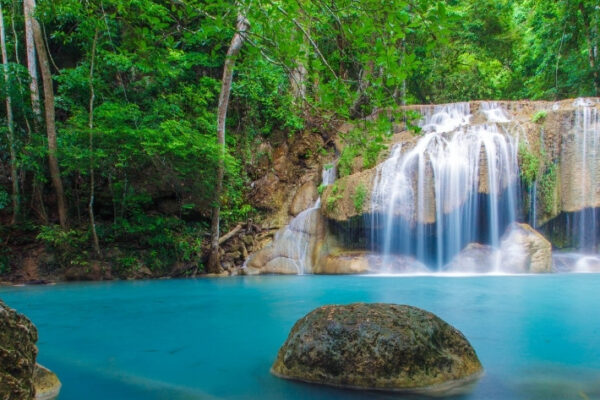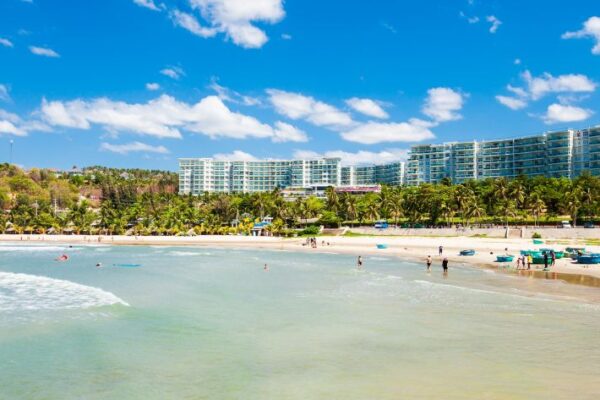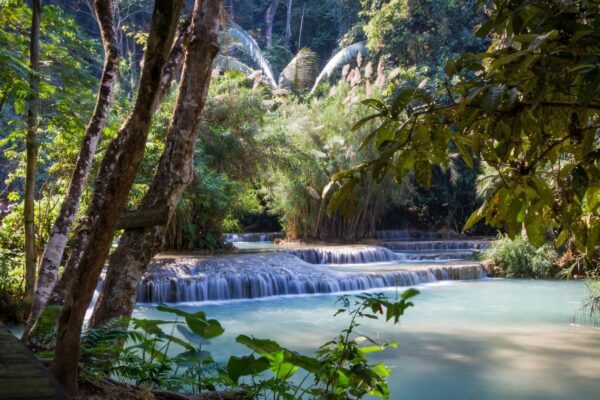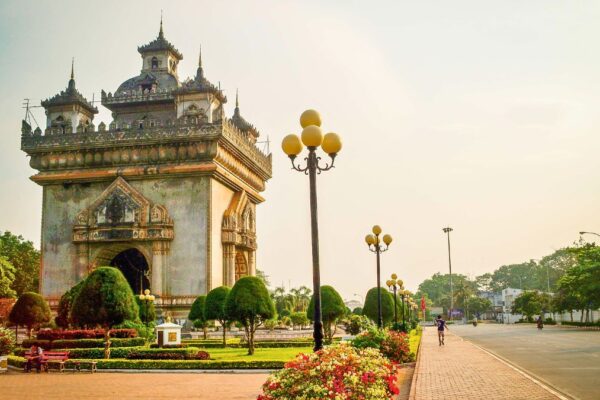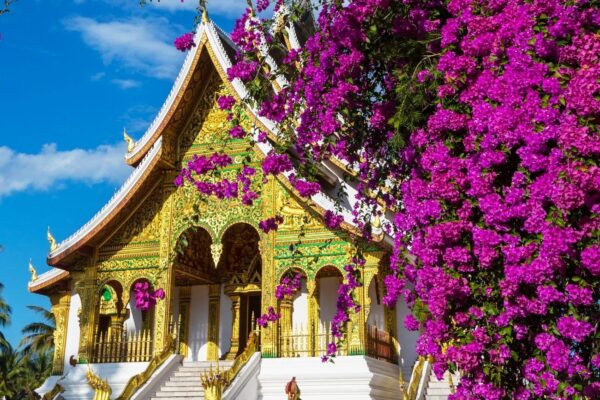Beautiful Places in Laos: Temples, Waterfalls, and Wild Landscapes
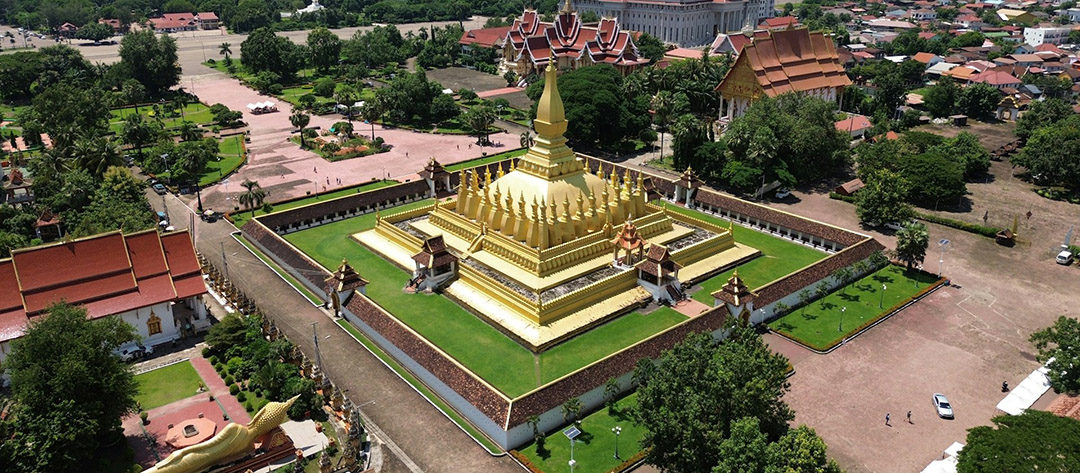
Laos moves at an unhurried rhythm where rivers mirror misty mountains and gilded temples glow at sunrise. This guide explores the most beautiful places in Laos—pairing iconic landmarks with lesser-known corners—and equips travelers with practical tips on timing, photography, and routing to turn inspiration into a seamless itinerary.
10 Beautiful Places in Laos That Should Be Added to Your Trip
Luang Prabang: A Timeless Gateway

Why it is beautiful
The UNESCO-listed old town sits elegantly at the confluence of the Mekong and Nam Khan, its gilded temples and teak houses wrapped by river curves and shaded by frangipani. At dawn, around 05:30–06:00, the alms-giving ritual adds a sense of lived spirituality that shapes the pace of the day. Evenings unfold under lantern light, with a soft hum of markets and river breezes.
Don’t miss
- Wat Xieng Thong, the most graceful of Luang Prabang’s temples, with intricate mosaics and a river-facing profile.
- Mount Phousi at sunset around 17:30–18:30, depending on the season, for a 360° sweep over rooftops, rivers, and distant hills.
- A day-trip to Kuang Si Falls, leaving by 07:30–08:00 to reach the blue pools before crowds.
- The night market on Sisavangvong Road is open from around 17:00 for textiles, simple dinners, and a leisurely stroll.
Tips
- Choose a stay within walking distance of the old town to make sunrise and sunset outings effortless.
- Visit temples early morning or late afternoon for calmer scenes and cooler air.
- Dress modestly for religious sites; shoulders and knees covered keeps the focus on the place, not on attire.
Suggested pacing: Spend three nights: Day 1 for temples and the river; Day 2 for Kuang Si; Day 3 for handicrafts, cooking classes, or cycling along the riverbanks.
Kuang Si Falls: Turquoise Tiers Among the Beautiful Places in Laos

Why it is beautiful
Often pictured but still surprising in person, Kuang Si is a chain of terraced waterfalls and calcite pools that glow a milky turquoise under a jungle canopy. Each tier has a slightly different hue and character, from still basins to thin, lace-like curtains of water.
How to visit
- Leave Luang Prabang around opening time (08:00) to enjoy the quietest hour; it also gives the most flattering light on the pools.
- Bring swimwear and a small towel; some pools are open for bathing, but respect any closed or roped-off areas.
- Allow time for the trail to the upper tiers and the viewpoint above the main fall.
Vang Vieng: The Classic Karst Countryside
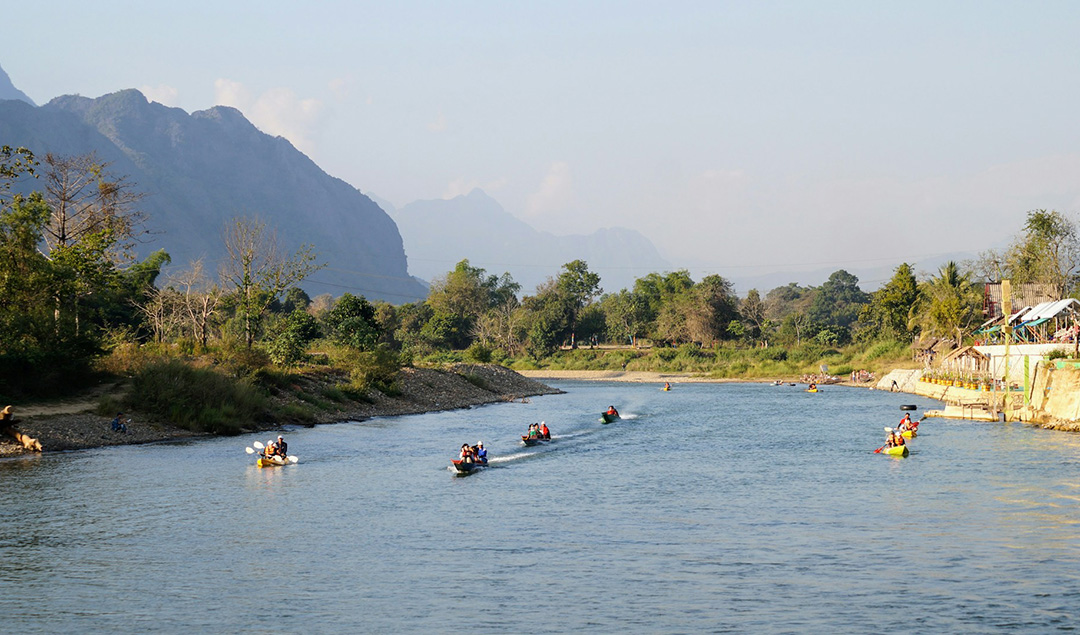
Why it is beautiful
Between Vientiane and Luang Prabang, Vang Vieng’s landscape erupts into karst—jagged limestone peaks that rise from rice fields and the calm Nam Song River. It’s a place where horizons look painted and sunsets catch on every ridge.
Highlights
- Nam Xay and Pha Ngern viewpoints for ridge-top panoramas; go for sunrise around 05:30–06:30 or pre-sunset to avoid midday heat.
- Kayaking the Nam Song, drifting past cliffs and small farms.
- Hot-air balloon flights (seasonal) for aerial views of the karst belt at sunrise around 06:00.
- Blue Lagoons: arrive by 08:00–09:00 to swim in clear water before day trippers arrive.
Tip: Book a room with a balcony that faces the mountains. Shoulder seasons (late 10–11, 02–03) often deliver crisp views with fewer crowds.
Plain of Jars (Xiangkhouang): Ancient Mystery
Why it is beautiful
Ancient stone jars—some as tall as a person—dot rolling highlands around Phonsavan. This megalithic landscape holds both intrigue and pathos, with misty mornings and long, golden afternoons ideal for slow walking.
Best sites
- Site 1 for scale and variety, plus informative signage.
- Sites 2 and 3 for quieter scenes with rural backdrops.
- A local UXO education center in town adds crucial context.
Safety and movement
Stick to marked trails; the region was heavily bombed during past conflicts, and clearance is an ongoing effort. The marked paths are well-maintained and safe for visitors.
Vientiane: Riverside Calm among the Beautiful Places in Laos
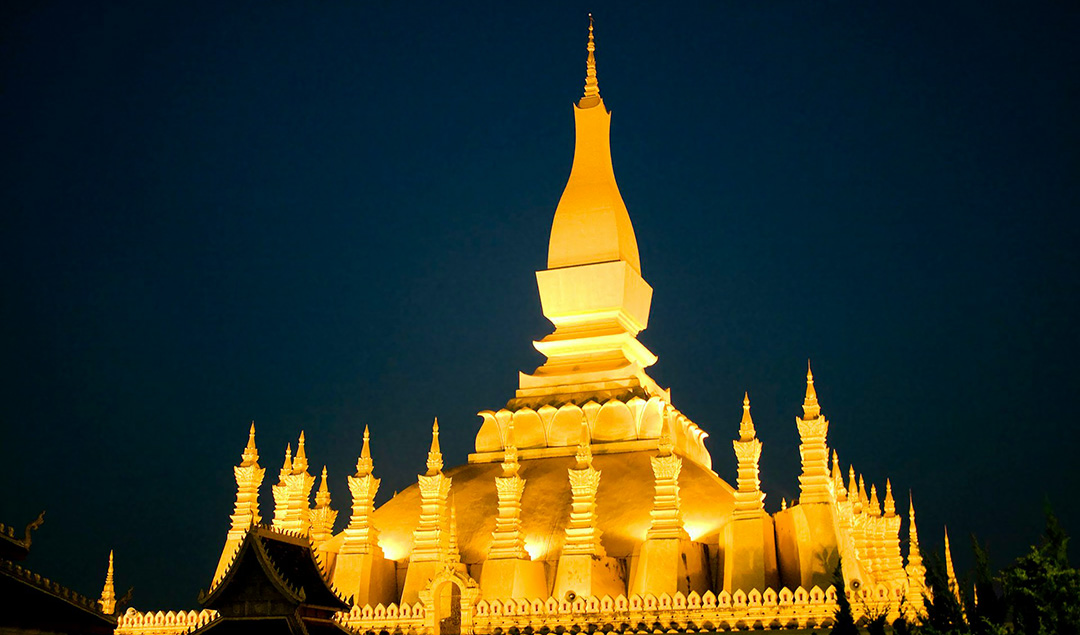
Why it is beautiful
The capital blends big-village charm with stately stupas and a river promenade. Sunsets slide across the Mekong, while the city’s scale makes it manageable: it’s easy to see the highlights in a day or two without rushing.
Highlights
- Pha That Luang, a gilded national symbol best seen mid-morning around 09:00–10:30 when the gold shines brightly.
- Patuxai, the triumphal arch with city views from the top.
- Wat Sisaket for its rows of tiny Buddha images and serene courtyard.
- The Mekong night market and riverfront from around 17:00 for an evening wander and simple street eats.
Tip: Rent a bicycle or hop between sights by tuk-tuk. Vientiane rewards a relaxed pace; save time for a café stop and a local Lao coffee.
Dining idea: Try laap (herbed minced meat or mushroom), sticky rice, and a river fish grilled over coals.
Bolaven Plateau (South): Waterfall Country Among the Beautiful Places in Laos
Why it is beautiful
South of Pakse, the Bolaven Plateau trades heat for cool highlands, coffee plantations for city traffic, and thunderous waterfalls for background noise. Morning mists drift over fields; afternoons bring sunshine and spray.
Must-see
- Tad Fane: Twin Falls dropping into a deep gorge—best viewed from platforms or a zipline park for perspective.
- Tad Yuang: wide and powerful, with steps down to a splashy base.
- Tad Lo: calmer pools and village life; a good overnight stop for those on the loop.
How to experience
- Drive or ride a motorbike on the short or long loop, staying at local guesthouses or eco-lodges that roast their own beans.
- Tour small coffee farms for tastings and to see arabica/robusta production.
Tip: Pack layers for cool mornings and occasional mist. Confident riders love the freedom of the loop; others can book a driver or join a guided day-trip, stringing several waterfalls.
4,000 Islands (Si Phan Don): Slow-life Mekong
Why it is beautiful
Near the Cambodian border, the Mekong dissolves into a maze of channels, sandbars, and palm-fringed islands. Days unfold slowly: cycling, hammock time, and ferrying between islets, with sunsets that stretch and glow.
Where to base
- Don Khon for a quieter vibe and easy access to waterfalls and bridges.
- Don Det for backpacker cafés, budget bungalows, and social evenings.
- Don Khong, the largest island, for a broader choice of guesthouses and more space.
Don’t miss
- Khone Phapheng Falls, the Mekong at its most muscular—more a cascade system than a single fall.
- Cycling across old French bridges linking Don Det and Don Khon.
- Dry-season sandbars and river beaches; in some years, boat trips look for freshwater dolphins (seasonal and not guaranteed).
Practical note: ATMs can be limited; bring enough cash. Plan your ferry timings and be prepared for basic but charming accommodations.
Nong Khiaw & Muang Ngoi: Northern Tranquility in the Beautiful Places in Laos
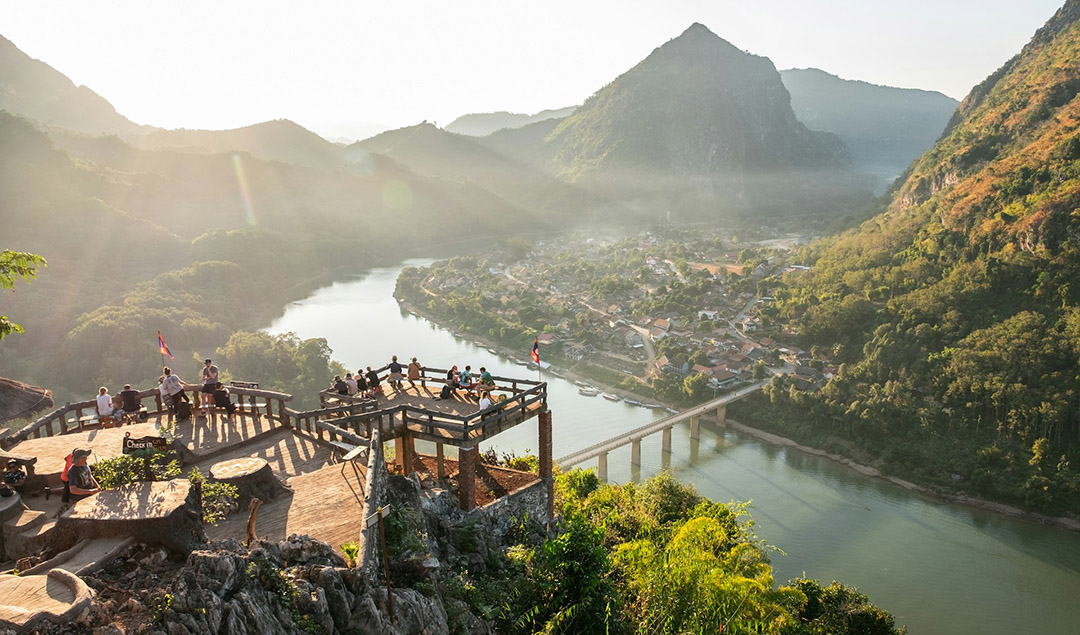
Why it is beautiful
North of Luang Prabang, the Nam Ou river threads through steep, forested karst. Nong Khiaw sits beneath towering cliffs with postcard bridges and mellow riverfront bungalows; Muang Ngoi, reachable by boat, slows time even further.
Highlights
- Pha Daeng (Nong Khiaw viewpoint): a steady climb to a sensational ridge panorama; start around 06:00 for cool air.
- Boat trip to Muang Ngoi for bamboo bungalows, village walks, and riverside sunsets.
- Short hikes to caves and rice field loops that return through villages.
Tip: Give this area two nights to catch both sunrise and sunset viewpoints, and to leave room for a slow afternoon on the riverbank.
Packing: Bring a headlamp for early hikes and an extra layer—mornings can be cool between seasons.
Thakhek Loop: Open-Road Scenery in the Beautiful Places in Laos
Why it is beautiful
The Thakhek Loop strings together rural karst valleys, caves with underground rivers, and cobalt-blue springs—ideal for travelers who want independence and open-road scenery.
Highlights
- Kong Lor Cave: a 7km boat journey through a cathedral-like limestone tunnel that opens into a hidden valley.
- Cool Springs for a clear, blue swim between riding stretches.
- Village stays and small guesthouses that bring in the social side of the loop.
Tip: Plan 3–4 days. Check road conditions, fuel stops, and daylight hours before setting off; aim to arrive at overnights before dusk around 17:30–18:30. If riding isn’t a fit, consider a driver or join an organized loop.
Safety note: Helmet always, lights for early/late riding, and a small toolkit. Keep speeds moderate on gravel sections.
Wat Phou (Champasak): Khmer Elegance Within the Beautiful Places in Laos
Why it is beautiful
Older than Angkor Wat, Wat Phou climbs terraces toward a sacred mountain, with processional avenues, barays, and lintel details that reward slow looking. It’s a serene complex where culture meets landscape—a gentle counterpart to the waterfalls of the south.
Pair with
- Champasak town’s heritage houses and shaded streets.
- A riverfront sunset with the temple’s outline in mind.
Tip: Late afternoon around 16:00–17:30 has softer light, fewer tour groups, and a cast of gold that settles across the stone. Allow time for the small museum to understand the site’s Khmer-era context.
>> Read More: Where To Visit In Laos For First-time Travelers?
Practical Essentials For A Perfect Laos Journey
The Ideal Time For A Trip To Laos
- November to February brings drier, cooler weather—ideal for hiking, viewpoints, and moving between destinations without heavy downpours.
- The green season (May–October) delivers lush countryside and fuller waterfalls; rains often come as afternoon showers rather than all-day events. Photographers love the saturated greens and dramatic skies.
- Shoulder periods (late 10 and 03–04) can be warm; haze may affect long views in some years. Start hikes early for clearer air.
>> Read More: Best Time To Visit Laos
How To Get Around
For long-distance travel within Laos, domestic flights are the most time-efficient way to connect the main hubs such as Vientiane, Luang Prabang, and Pakse. If flying isn’t preferred, intercity buses and minivans cover most routes and offer a more budget-friendly option; however, it’s best to book with reputable operators to ensure vehicle comfort and safer driving standards. In the northern regions, where available, trains provide a scenic and swift alternative for specific segments, offering a unique way to experience the countryside.
For local exploration, bicycles, e-bikes, and scooters are popular choices, giving travelers the freedom to navigate towns and surrounding areas at their own pace. It’s important to always check the brakes and lights before riding, wear a helmet for safety, and avoid riding at night outside urban areas.
For those who prefer not to ride or are traveling with family, hiring drivers or guided transfers adds extra comfort, flexibility, and peace of mind, especially when managing tight itineraries.
Culture & safety
When visiting temples and sacred sites, it is important to dress respectfully. This means covering your shoulders and knees, removing your shoes at entrances, and maintaining a quiet, reverent demeanor. Always ask for permission before photographing local people, especially monks, to honor cultural sensitivities.
In some areas, such as Xiangkhouang and other rural locations, there are risks associated with unexploded ordnance (UXO). Therefore, visitors should strictly adhere to marked paths and official sites for their safety.
To stay comfortable and healthy while exploring, travelers should carry water, wear a hat for sun protection, and plan more physically demanding viewpoints or hikes for the early morning hours when temperatures are cooler. Basic health precautions are highly recommended, including obtaining travel insurance, bringing necessary medications, applying insect repellent, and carrying a lightweight rain jacket during the rainy season.
Money
In most parts of Laos, especially outside major towns, cash is the preferred payment method. While ATMs are generally available in cities and larger hubs, they may be hard to find on remote islands or in rural areas.
It’s advisable to carry small denominations for everyday expenses, such as markets, tuk-tuks, and ferries.
Many guesthouses operate on a cash-only basis; however, some midrange hotels do accept credit or debit cards, often with a surcharge.
Since exchange rates can vary, it’s best to convert a reasonable amount of currency in larger towns and keep a financial buffer for days spent in more remote areas.
Connectivity and practicalities
Local SIM cards are affordable and useful for navigation and communication throughout Laos. However, power outages can occasionally occur, especially in rural regions, so having a fully charged power bank is a smart backup. Laundry services are commonly available across hotels and guesthouses, making it easy to travel light and wash clothes as needed during a longer stay.
Responsible travel notes
Travelers are encouraged to contribute to sustainability and respect local environments. Refilling water bottles at hotels or guesthouses is a helpful practice, as many of these establishments provide filtered water, which reduces plastic waste. Supporting local guides and family-operated accommodations is particularly important in destinations such as Nong Khiaw, Thakhek, Bolaven, and the 4,000 Islands, as it helps boost community livelihoods.
Additionally, it is crucial to respect wildlife and natural sites. Avoid flying drones in areas where it is prohibited, never climb on fragile temple structures, and always carry out your litter, especially in vulnerable environments like waterfalls or jungles.
>> Read More: Laos Travel Requirements Explained – Entry, Visas & Safety Tips
Best Itinerary to Visit the Most Beautiful Places in Laos

Day 1: Arrival in Luang Prabang
Arrive in the tranquil city of Luang Prabang, where your private guide and driver will warmly welcome you. Settle into your hotel and take some time to relax after your journey. In the evening, enjoy a special welcome dinner at Friends Restaurant, a social enterprise that supports disadvantaged youth. This is the perfect start to immerse yourself in the warmth and culture of Laos.
Highlights:
- Private guide and driver greeting
- Hotel check-in
- Welcome dinner at Friends Restaurant
Day 2: Luang Prabang – Full-day Heritage Tour
Spend a day exploring Luang Prabang’s rich heritage, starting with the lively Morning Market and ancient temples like Wat Mai and Wat Xieng Thong. Visit traditional craft villages and cultural centers to learn about local arts. End the day with panoramic city views from Mount Phousi and a stroll through the vibrant Night Market, full of handmade textiles.
Highlights:
- Visit Morning Market and iconic temples
- Explore Ban Xangkhong and Ban Xienglek craft villages
- Climb Mount Phousi for panoramic views
- Evening at Night Market
Day 3: Luang Prabang – Pak Ou Caves – Kuang Si Waterfall

Begin early to take part in the sacred morning almsgiving ceremony with local monks. Travel by boat to the famous Pak Ou Caves, home to thousands of Buddha statues. Spend the afternoon at the stunning Kuang Si Waterfall and visit the Free the Bears sanctuary and a local buffalo dairy farm, experiencing Laos’ wildlife and sustainable farming.
Highlights:
- Participate in morning almsgiving
- Explore Buddha-filled Pak Ou Caves
- Swim at Kuang Si Waterfall
- Visit Free the Bears sanctuary and buffalo dairy farm
Day 4: Luang Prabang – Nature Day & Elephant Experience
Spend a meaningful day at the Elephant Park Project where you’ll learn about elephant rescue efforts. Enjoy optional elephant rides and a short boat ride to the idyllic Tad Sae Waterfalls. This day blends nature, conservation, and adventure, supporting community-based eco-programs.
Highlights:
- Elephant Park Project visit
- Optional elephant rides
- Boat trip to Tad Sae Waterfalls
- Support elephant conservation efforts
Day 5: Luang Prabang – Flight to Xiengkhouang – The Plain Of Jars
Fly to Xiengkhouang and explore the mysterious Plain of Jars, an archaeological wonder scattered with ancient megalithic stone jars. Visit War Spoon Village to learn about local culture and history before settling in the peaceful town of Phonsavanh.
Highlights:
- Flight to Xiengkhouang
- Explore Plain of Jars Sites I and II
- Visit War Spoon Village
- Leisure time in Phonsavanh
Day 6: Phonsavanh – Flight to Vientiane
Visit the ruins of the ancient Phuan kingdom and local markets in the morning. Fly to Vientiane, Laos’ relaxed capital, and visit the Patuxai Monument for panoramic views and the COPE Visitor Centre that raises awareness about unexploded ordnance issues affecting the country.
Highlights:
- Explore Phuan ruins and markets
- Flight to Vientiane
- Visit Patuxai Monument and COPE Centre
Day 7: Vientiane – Full-day City Tour
Discover Vientiane’s unique temples, museums, and markets including Vat Sisaket, Wat Prakeo, and the golden Pha That Luang stupa. Shop in vibrant markets and unwind by the Mekong River at sunset, experiencing the city’s laid-back charm.
Highlights:
- Visit Vat Sisaket, Wat Prakeo, Pha That Luang
- Explore Lao National Museum and Wat Si Muang
- Afternoon shopping at Talat Sao and Talat Kouadin markets
- Evening walk along Mekong Riverside
Day 8: Vientiane – Flight to Pakse – Bolaven Plateau
Fly to Pakse and delve into the beautiful Bolaven Plateau, visiting coffee plantations and the ethnic Katu village of Ban Katuu. Explore bustling markets around the Japanese Bridge and settle into your peaceful resort surrounded by nature.
Highlights:
- Flight to Pakse
- Coffee plantation and Ban Katuu village tour
- Browse Talat Dao Heung Market
- Resort stay in Bolaven Plateau
Day 9: Bolaven Plateau – Siphandon (The 4000 Islands)
Visit the spectacular waterfalls of Tad Fane and Tad Yeung, then travel to the tranquil Siphandon archipelago. Cruise to Done Khone island and enjoy the peaceful atmosphere with chances to spot endangered Irrawaddy dolphins.
Highlights:
- Visit Tad Fane and Tad Yeung waterfalls
- Travel to Siphandon’s 4000 Islands
- Boat cruise to Done Khone island
- Spot Irrawaddy dolphins
Day 10: Siphandon – Champasak
Embark on a rewarding elephant trek through wetlands and jungle with a local mahout. Share a traditional Lao lunch in a village before exploring the ancient Khmer ruins of Wat Um Tomo and the charming town of Champasak.
Highlights:
- Elephant trek with mahout
- Traditional village lunch
- Visit Wat Um Tomo ruins
- Explore Champasak and Shadow Puppet Theatre
Day 11: Champasak – Wat Phou
Discover the magnificent Wat Phou, a UNESCO World Heritage site with impressive Khmer temple ruins. Visit the Wat Phou Museum and enjoy a leisurely afternoon with riverside dining, soaking in the peaceful surroundings.
Highlights:
- Explore Wat Phou temple complex
- Visit Wat Phou Museum
- Leisure afternoon and riverside dinner
Day 12: Champasak – Departure
Relax and enjoy a slow morning before transferring to Pakse Airport for your next destination. Reflect on the incredible cultural, historical, and natural experiences from your trip to Laos.
Highlights:
- Leisurely final morning and lunch
- Transfer to Pakse Airport
- Onward flights to Cambodia or Thailand
>> Explore Other Tour: The Real Luang Prabang Tour & Southern Cruise
Final Thoughts
From the saffron dawns in Luang Prabang to the milky-blue terraces of Kuang Si, the knife-edge skylines of Vang Vieng, and the serene mystery of the Plain of Jars, Laos is a country best experienced at a leisurely pace. Its beauty lies not only in the stunning sights but also in the moments in between—the river crossings, conversations at the market, and the pauses on ridgelines where the landscape seems to breathe.
If you’re looking to explore the stunning beauty of Laos effortlessly, Asia Travel Pioneer is here to help! We craft personalized itineraries featuring handpicked accommodations and knowledgeable guides who unveil the best photo opportunities. With a relaxed pace and insider tips, you’ll seamlessly enjoy breathtaking waterfalls, majestic temples, and stunning viewpoints, ensuring that every day concludes with unforgettable memories. Let’s embark on this incredible journey together, filled with awe-inspiring experiences!
